The Ithaka Walk
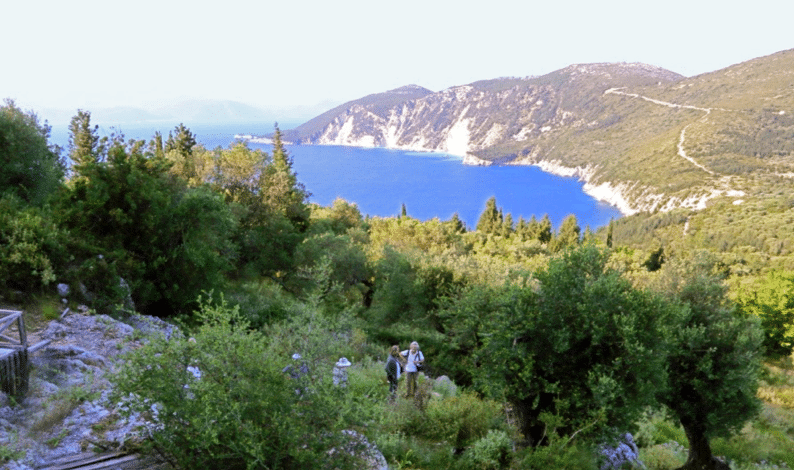
Ithaka gave you the marvellous journey ~ Cavafy
The Tour begins. We met up in Istanbul, ancient Byzantium, the Imperial megalopolis, one of the oldest living cities on earth. From what is today a deeply troubled place, but then calm and bright on a clear May morning, we set out on our marvellous journey with the Muslim call to prayer ringing in our ears. We were an eclectic company drawn together by our common interest in the great Homeric epic poems, the Odyssey and the Iliad, and obviously destined to become very good friends.The aim of our travels was to engage with the Homeric world in a unique and very concrete way; to visit places named in the poems, to see objects and buildings (now ruins) described in them, to hear the stories, rituals, ideas and beliefs that fermented in the great poet’s mind and imagination. Our journey would take us to the citadels of the Bronze Age Minoan and Mycenaean civilizations, Knossos, Phaistos, Troy, and Mycenae; also to iconic eighth century BCE cities and sanctuaries of Homer’s own time. It would take us far off the beaten track to the temples of Apollo Smintheus at Gulpinar and Athene at Assos (the Homeric Pedasos), to Dodoni the oldest oracle in Hellas, the Nekromanteion at Ephre where inquirers called up the shades of the dead, and to the Acheron, the Underworld River of Hades, fed at its source by countless miraculous springs. Most marvellous of all, our journey brought us to the island of Ithaka deep in the deep blue Ionian Sea, a harbour that was new to us, yet also a kind of homecoming.
We knew, of 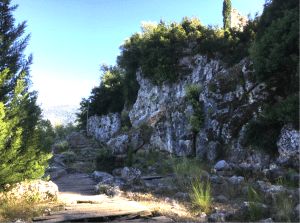 course that the scholarly world was rife with debates about whether modern Ithaka is in fact the island kingdom of Homer’s Odysseus. But on that summer afternoon in Vathy it didn’t seem to matter. Who would say that this luminous place was not Ithaka? It is deliciously ironic that Homer describes how the hero Odysseus fails to recognize his homeland when he returns at last after twenty years, as of course he would, we all would. Memory slides and familiar things subtly change in our recollection over time and in the context of new scenes. It is through such episodes that the poet reminds us that Odysseus’ saga of return and reunion is also a story of loss. But perhaps I should remind the reader of Odysseus’ homecoming.
course that the scholarly world was rife with debates about whether modern Ithaka is in fact the island kingdom of Homer’s Odysseus. But on that summer afternoon in Vathy it didn’t seem to matter. Who would say that this luminous place was not Ithaka? It is deliciously ironic that Homer describes how the hero Odysseus fails to recognize his homeland when he returns at last after twenty years, as of course he would, we all would. Memory slides and familiar things subtly change in our recollection over time and in the context of new scenes. It is through such episodes that the poet reminds us that Odysseus’ saga of return and reunion is also a story of loss. But perhaps I should remind the reader of Odysseus’ homecoming.
Odysseus’ final destination in his wanderings is to the island of the Phaiakian people, a Golden Age kingdom of peace and the most refined civility. The King and Queen, Alkinoös and Arête, promise him conveyance home to Ithaka and give him gifts of clothing and gold. Finally in an impulse of extraordinary largesse, King Alkinoös asks each of the welve Phaiakian noblemen to give Odysseus a farewell gift of a great tripod lebetes (a tripod and cauldron set), presumably adding a set of his own that would bring the final number of tripod lebetes to thirteen (13. 13-15)1. We can be sure of the numbers because King Alkinoös specifies that “twelve glorious Kings hold sway as rulers in the community and I myself am the thirteenth” (8. 390-91). For Homer and his contemporary listeners, such a gift of thirteen tripod lebetes would have been lavish on an inconceivable scale.
So having said his farewells, Odysseus steps aboard the magical ship and falls into an enchanted sleep so deep that he does not wake even when the Phaiakian sailors gently lift him onto the beach at Ithaka, pile up the wonderful gifts beside him and sail back into the tremendum.2 With their departure, the portal closes and the great Mythic Heroic Age comes to an end. Our Age, the Iron Age of Literalism has begun.
At last Odysseus rouses, opens his eyes but has no idea where he is. He cannot recognize his longed for homeland. He paces the beach in terrible disappointment and sorrow until he sees a shepherd boy and asks the name of this place. But the boy is really the goddess Athene in disguise (we are not quite in the Age of Literalism yet) and her answer is designed to elicit for Odysseus the gentle déjà vu of recognition. Gradually, the strangeness lifts from his mind, his surroundings assume their old, familiar aspect and at last he knows with unshakeable certainty that he is in the land of his fathers. He falls to his knees and kisses the grain-giving Ithacan soil. Next (having assumed her goddess form) Athene advises Odysseus to hide his treasure in the nearby Cave of the Nymphs, a distinctive place with two entrances. Afterwards the man and the goddess plot together about what Odysseus must do to reclaim his kingdom…
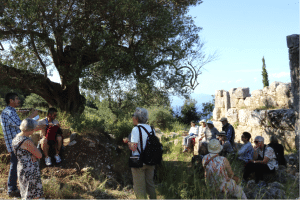 So after a hearty breakfast, the ASA Tour Group set out with anticipation and some alarm as the road wound steper and narrower up the precipitous slopes of Homer’s “tall, leaf-trembling Mt. Neritos” to the northern part of Ithaka. There were many fascinating stops and detours on the way, but our most significant destination would be the Archaeological Museum at Stavos where we would see, among many other significant artefacts, the fragmentary remains of twelve tripod lebetes that were found, in a cave at Polis Bay!
So after a hearty breakfast, the ASA Tour Group set out with anticipation and some alarm as the road wound steper and narrower up the precipitous slopes of Homer’s “tall, leaf-trembling Mt. Neritos” to the northern part of Ithaka. There were many fascinating stops and detours on the way, but our most significant destination would be the Archaeological Museum at Stavos where we would see, among many other significant artefacts, the fragmentary remains of twelve tripod lebetes that were found, in a cave at Polis Bay!
The twelve tripods were discovered in the 1930’s by the British archaeologist Sylvia e great Mythic Heroic Age comes to an end. Our Age, the Iron Age of Literalism has begunBenton.3 However Dimitrios Loizos, an early owner of the site, maintained that he had ound and melted down another tripod over sixty years before Benton’s exploration. (It is rumoured that Lozios got rich in the 1870’s selling gold coins that he found in the cave.) I am always surprised that there is so little comment about how these twelve (or thirteen) tripod lebetes match up with the Homeric episode of gift giving on Scheria. It was a sensational discovery; bronze tripod lebetes were, as I said earlier, almost inconceivably valuable and prestigious in the ninth and eighth century BCE. The only other comparable finds of tripods lebetes have been at the great wealthy sanctuaries of Olympia and Delphi.
Sylvia Benton also found pottery and artefacts that established Lozios Cave in Polis Bay as a significant Mycenaean shrine with continuity of use to Roman times. Finds from Benton’s excavation also made it clear that the cave in Polis Bay was the focus for a cult around the figure of Odysseus from 900 BCE onwards, that is before the Odyssey and the Iliad were composed sometime around 750 BCE. In other words, the archaeology demonstrated that Odysseus was already a hero on Ithaka before the poet we call Homer was born!4
To my mind it is entirely plausible that tales about a sacred cave on the edge of the Greek world, on the doorsill to foreign lands, full of recently dedicated tripods honouring an ancient hero King called Odysseus, would finally have reached the ears of a receptive bard in far away Ionia. Indeed, we know there was contact between the two places because vases made in Ionia around 700 BCE have been found at Polis Bay. It may well have been tales such as these that moved this nimble-minded bard to include Odysseus as a major figure in his stories about the Trojan War and to invent the Phaiakian gift of thirteen tripod lebetes that serendipitously end up in a cave on Ithaka! Perhaps this bard we call Homer subtly acknowledges all of this in the fact that Odysseus never shows any intention of retrieving his treasure.
It 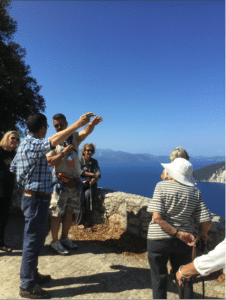 turned out that we were thwarted in our hopes of seeing the tripod fragments; Stavros Archaeological Museum was closed because of recent earthquake damage. Happily, the gods had not forgotten us. Our guide Antonis was able to arrange (and translate for us) a lecture on the Museum’s holdings by Spiros Couvaras, a local man deeply versed and immersed in Ithacan archaeology and the Homeric stories. That was not all. After the lecture, Antonis and Spiros took us on a trek that became a pilgrimage and rite of passage to the very heart of the island, to a unique place that amazingly answered to the description of the location and layout of Odysseus’ palace in the Odyssey!
turned out that we were thwarted in our hopes of seeing the tripod fragments; Stavros Archaeological Museum was closed because of recent earthquake damage. Happily, the gods had not forgotten us. Our guide Antonis was able to arrange (and translate for us) a lecture on the Museum’s holdings by Spiros Couvaras, a local man deeply versed and immersed in Ithacan archaeology and the Homeric stories. That was not all. After the lecture, Antonis and Spiros took us on a trek that became a pilgrimage and rite of passage to the very heart of the island, to a unique place that amazingly answered to the description of the location and layout of Odysseus’ palace in the Odyssey!
The road up from Stavros was too narrow even for our remarkable driver Dimitris to negotiate safely, so we exchanged the ASA bus for a small red van and were ferried in instalments up to the village of Exogi. After some deliberation, we left the road near the church of Agia Marina and began our walk down venerable cobbled stone paths that sometimes became simple goat tracks (complete with goats). We walked in the soft Ithacan afternoon shaded by oak and wild olive, through a fragrant landscape of yellow daisies, purple nut sedge, convolvulus, red poppies, thistles, mint, white clover, chamomile, oregano, sage and a riot of flowering grasses. It was a strange and marvellous thing to see, a group of elderly Australians, some well over 80, managing a long walk over steep and occasionally difficult terrain with determination and much hilarity.
We walked (many of us caught short in unsuitable footwear) until our ankles and knees were sore. At last on a lofty eminence, a most ideal vantage point overlooking good, cultivable land, we came upon a truly massive structure, the remains of an extensive two or three-story Mycenaean-style palatial complex. The place is popularly called the “School of Homer”, but on the map it is named Agios (Holy) Athanasios after the saint in whose honour a small chapel had been built on the ancient walls. Indeed, some of the ancient material has been used in constructing the chapel and also in terracing the hillside, (a practice of reuse that, along with constant earthquake activity, explains the difficulty of interpreting Ithacan archaeological data.) The site was investigated by the British School in the 1930s and was listed in 1943 by the Roberts Commission for the “Protection of Cultural Treasures in War Areas”. Recent excavation undertaken by the University of Ioannina was discontinued in 2010 through lack of finance and the reports have never been published. Nevertheless this place has all the aspects of a Mycenaean stronghold, and like the rest of the Mycenaean world, was abandoned sometime after 1100 BCE. As at Polis Bay, occupation had resumed around 900 BCE and continued until Roman times. Furthermore, a significant connection between Agios Athanasios and Polis Bay can be inferred on the basis of Mycenaean sherds found at strategic intervals along a direct route between the two sites.
We approached the ruins at the craggy upper level. There was no official entrance, no prohibited area, no ticket, no guard; we were free to clamber over these spectacular ruins and peer into excavation pits without restriction. After a refreshment of sweet dried figs we began our exploration. We were seeing massive walls and heavy ashlar masonry reminiscent of the citadels we had so recently visited at Mycenae and Tiryns. With its command of the surrounding fertile land and of the three bays, Aphales to the north, Polis to the east and Phrikes further to the west, Agios Athanasios was a perfect location for the citadel of a shrewd and forward thinking Mycenaean King.
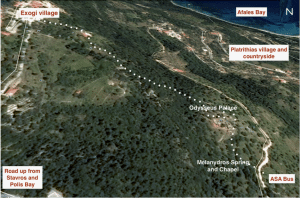 It is not my intention to enter the debate about whether Agios Athanasios is “really” the site of Odysseus’ palace; however, it is impossible to ignore its many correspondences to topographical descriptions in the Odyssey. It makes perfect sense that, as with the tripods at Polis Bay, our inventive poet in Ionia would assimilate into his storytelling details he had heard about the citadel and the Ithacan countryside. Agios Athanasios is close to the Pilicata Ridge, which is very plausibly Homer’s “Hill of Hermes”; the place where the noble swineherd Eumaios was walking on his way back from the palace when he saw the suitors’ ship returning from the failed attempt to ambush Telemachos. Eumaios says, “I was above the city, where the Hill of Hermes is, going on my way, when I saw a swift ship coming into our harbor…” (16.471-73). Eumaios’ few lines are very useful because they pinpoint the spatial relationship between Odysseus’ palace and the other major landmarks. We learn first, that the Hill of Hermes is near Odysseus’ palace second, that the Hill of Hermes is above the city or polis of Ithaka and third, that both are near the main harbour (as you would expect). The fact that Polis Bay has retained the name City Bay (“polis” = “city”) is a striking survival from the time when it was a major harbour close to the city.
It is not my intention to enter the debate about whether Agios Athanasios is “really” the site of Odysseus’ palace; however, it is impossible to ignore its many correspondences to topographical descriptions in the Odyssey. It makes perfect sense that, as with the tripods at Polis Bay, our inventive poet in Ionia would assimilate into his storytelling details he had heard about the citadel and the Ithacan countryside. Agios Athanasios is close to the Pilicata Ridge, which is very plausibly Homer’s “Hill of Hermes”; the place where the noble swineherd Eumaios was walking on his way back from the palace when he saw the suitors’ ship returning from the failed attempt to ambush Telemachos. Eumaios says, “I was above the city, where the Hill of Hermes is, going on my way, when I saw a swift ship coming into our harbor…” (16.471-73). Eumaios’ few lines are very useful because they pinpoint the spatial relationship between Odysseus’ palace and the other major landmarks. We learn first, that the Hill of Hermes is near Odysseus’ palace second, that the Hill of Hermes is above the city or polis of Ithaka and third, that both are near the main harbour (as you would expect). The fact that Polis Bay has retained the name City Bay (“polis” = “city”) is a striking survival from the time when it was a major harbour close to the city.
Another Homeric clue to the location of the city of Ithaca is that it lies “beneath wooded Mt. Neion” (modern Mt. Exogi) which, a glance at a map will show, is just north of Polis Bay (3.81). Then again, when Athene visits Telemachos in disguise as Mentes an old friend of Odysseus, she travels from Olympos to Ithaka in a flash of light. But in order to forestall any questions about where her ship might be, she explains that it is at Rheithron (modern Phrikes) “away from the city”, as indeed it is (1.186).
W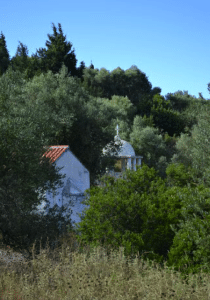 e followed a narrow, winding, bushy path down to the lower level of the ruin. Russell Casey’s picture, taken in the brilliant light and deep shadow of late afternoon, shows some of our group emerging from the undergrowth. Now we could see that the levels were set into a terrace of natural bedrock and connected by a wide carved staircase. We saw cellars, storage areas and drainage conduits. The large downstairs area may once have been a rustic megaron with an earthen floor and rough-hewn hearth, a place for feasting and storytelling, and perhaps a bow-stringing contest! We even clambered up that extraordinary staircase where Penelope, or someone like her, may once have ascended to her chamber accompanied by attendant women. Later, as we followed the Neolithic circuit walls away from the palace, we came to an underground cistern with the same kind of distinctively Mycenaean corbelled vault that we had seen at Mycenae.
e followed a narrow, winding, bushy path down to the lower level of the ruin. Russell Casey’s picture, taken in the brilliant light and deep shadow of late afternoon, shows some of our group emerging from the undergrowth. Now we could see that the levels were set into a terrace of natural bedrock and connected by a wide carved staircase. We saw cellars, storage areas and drainage conduits. The large downstairs area may once have been a rustic megaron with an earthen floor and rough-hewn hearth, a place for feasting and storytelling, and perhaps a bow-stringing contest! We even clambered up that extraordinary staircase where Penelope, or someone like her, may once have ascended to her chamber accompanied by attendant women. Later, as we followed the Neolithic circuit walls away from the palace, we came to an underground cistern with the same kind of distinctively Mycenaean corbelled vault that we had seen at Mycenae.
Finally we trudged off, following the old path down towards the rich farmland of Platrithias, an agricultural area not too far from the “palace” and well suited to be Laertes’ orchard and country estate. One could imagine that the same fruits are grown tday as when Laertes gave his son the gift of 13 pear trees, 10 apples, 40 figs and 50 vines (24. 340-24). The day was far gone and we were walking silently in single file when we emerged from the dense foliage to the amused surprise of a startled farmer who called to us (in Greek) that we must have risen up from the earth. I thought privately that we might more properly be compared to the shades of the slaughtered suitors following Hermes along mouldering pathways to the land of dreams and the Underworld! (24. 1-14)
It was now that we came to what we learned was the Melanidros or Melanydros (Black water) spring, a rich, lush place, one of several sources of good water in the area. It was of particular interest because Hmer reports that twenty of Penelope’s maidservants were sent to fill vessels at the Melanydros spring (20.158). But we had walked a long way and our aching feet were a distraction from the tribulations of Bronze Age maidservants….
….. At this point, I will let Barry (aka anon) tell his version of that day. It is fitting that he should have the last word:
Down the goat-path
Off the village road one pace
We stepped into an unknown place.
Down a goat-path made of stone,
Well outside our comfort zone
Searching for your citadel,
Your stronghold here in Ithaca.
Was it real or mythic? Ah,
No-one now can tell.
An ancient pathway, very old
Perhaps a thousand years we’re told.
And on this track of marbled stone
Trodden now by goats alone,
Bordered by wildflowers and herbs
That no-one now picks or disturbs,
Fat white sage, and fragrant thyme
Pink thistles and blackberry climb.
Deviser of the Trojan ruse,
Master of the citadel
With Cyclop walls and two-bay views,
Did you ever know full well
That in your clever ponderings,
And in your longest wanderings
That the suffering you felt
Was equal to the pain you dealt?
Once, the fortress stood before
But now the stronghold’s strong no more,
Poseidon’s quakes have shaken it
And Time’s sad toll has taken it
And rendered it to ruin,
Long-grassed now and wildflower strewn.
So down and further down we went,
We watched each foothold with intent,
Some ill-shod, and some with cane.
How could this long and strange descent
Keep on and on and down again?
Around and down another bend,
We wondered: would it never end?
We did not stumble nor relent;
At last the rocky way had ended.
Half a mountain we’d descended.
O dizzy us, light-headed, spent.
And standing patiently for us,
O welcome sight, our waiting bus!
Sore legs would be the aftermath,
And surely we were stonkered,
But together down the long goat-path
Together we had conquered.
— Anon.
By Heather Sebo
1 Book and line references to Homer’s Odyssey are given in brackets.
2 I use the Latin word tremendum to refer to the archetypal otherness that characterizes the world of Odysseus’ wanderings.
3 Sylvia Benton’s finds and drawings are the only record because the Polis Bay cave (Lozios Cave) collapsed in the 1953 earthquake and is now completely underwater.
4 For references to Benton’s work see, J. Luce,1998. Celebrating Homer’s Landscapes. Yale University Press, p.247.n.14. Also, W.A. Heurtley, 1939-40. “Excavations in Ithaca, 1930-35”. The Annual of the British School at Athens, Vol.40 (1939/40). pp.1-13.
Images
[1] The group emerges at the lower levels, image: Russell Casey
[2] Upper & lower levels of Agios Athanasios (Odysseus’ citadel) with staircase
[3] Refreshment on the upper levels at Agios Athanasios, image: Russell Casey
[4] Deliberations at Exogi overlooking Afales Bay
[5] Route from Exogi to Agios Anathasios and Melanydros Spring at Platrithias.
[6] Chapel at the Melanydros Spring

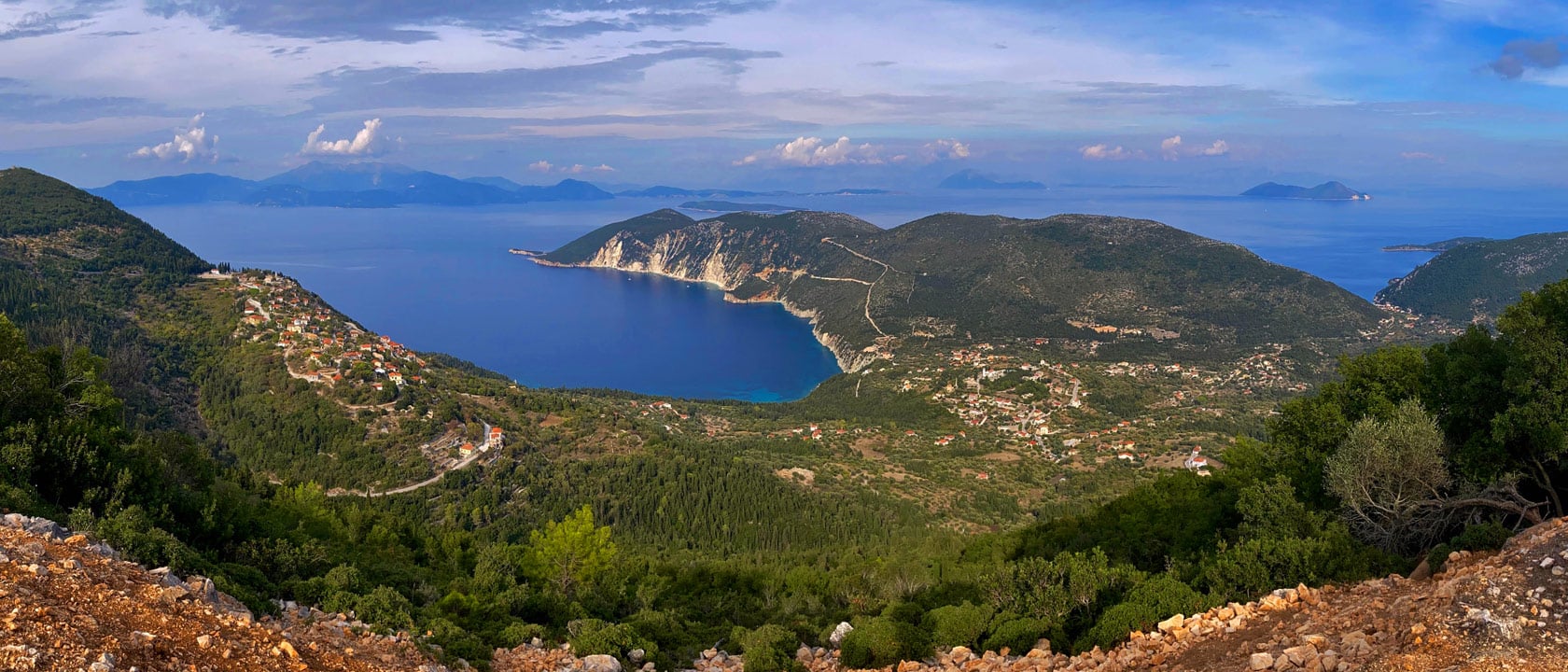 Between Sea and Sky: Homer’s Greek Islands 2026
Between Sea and Sky: Homer’s Greek Islands 2026